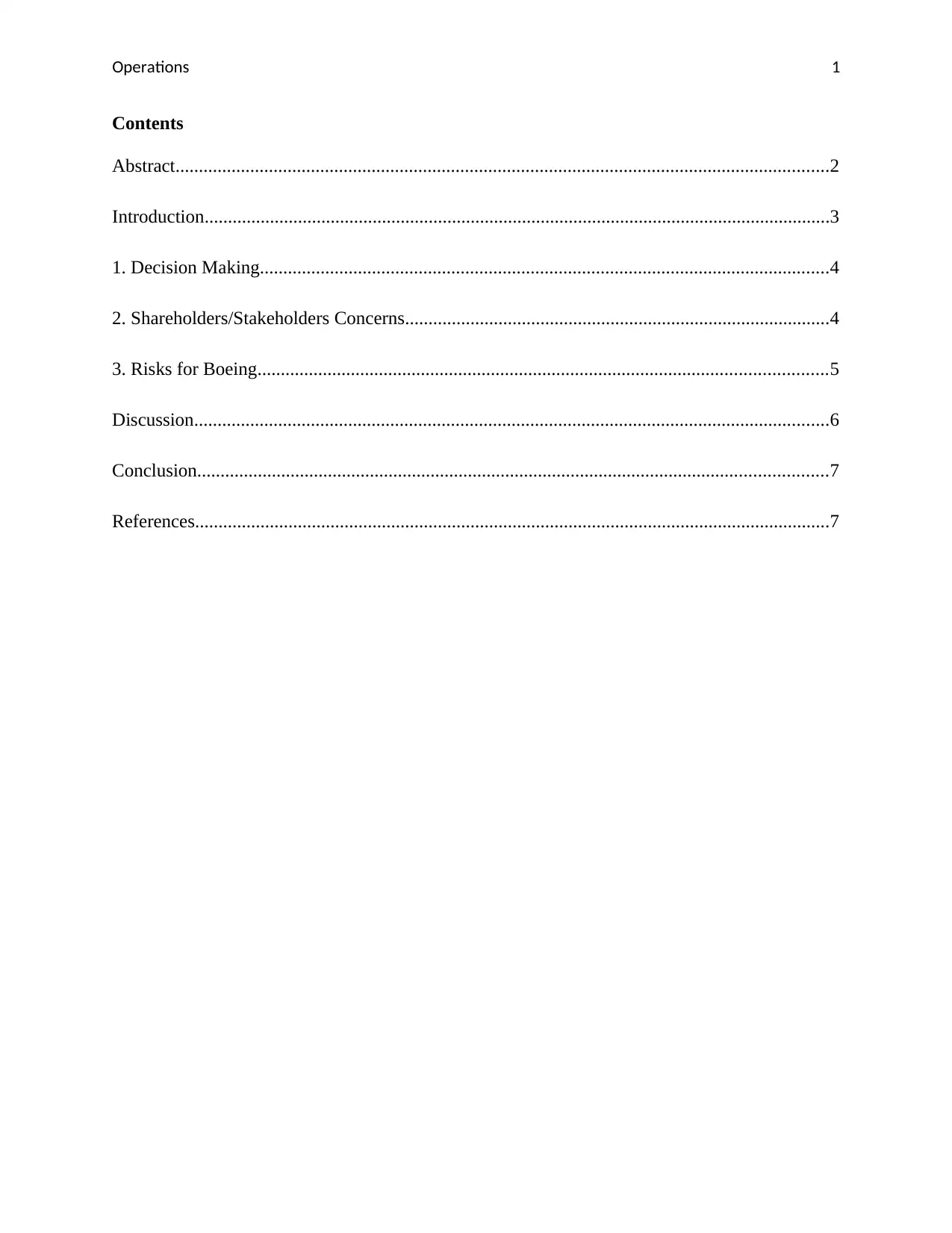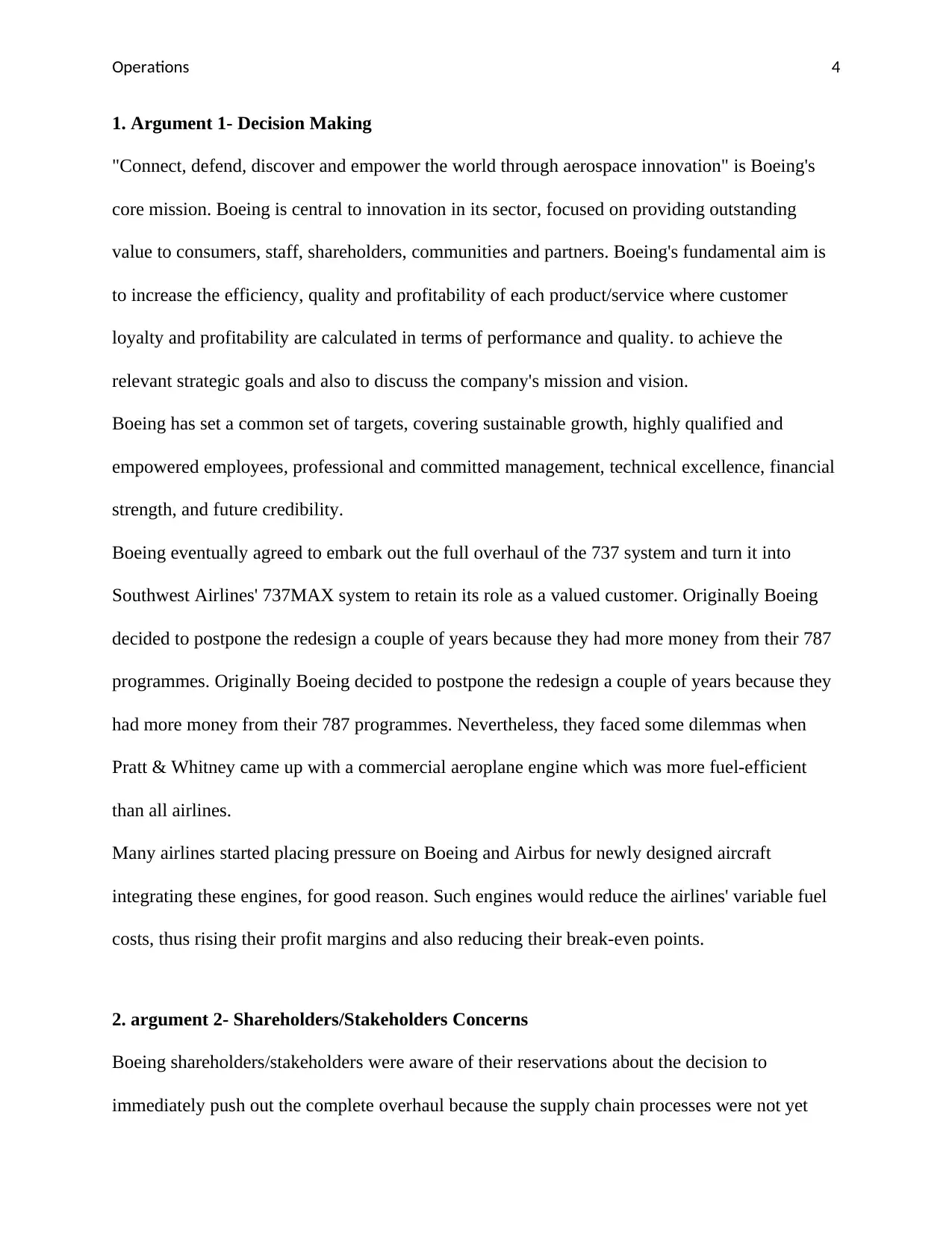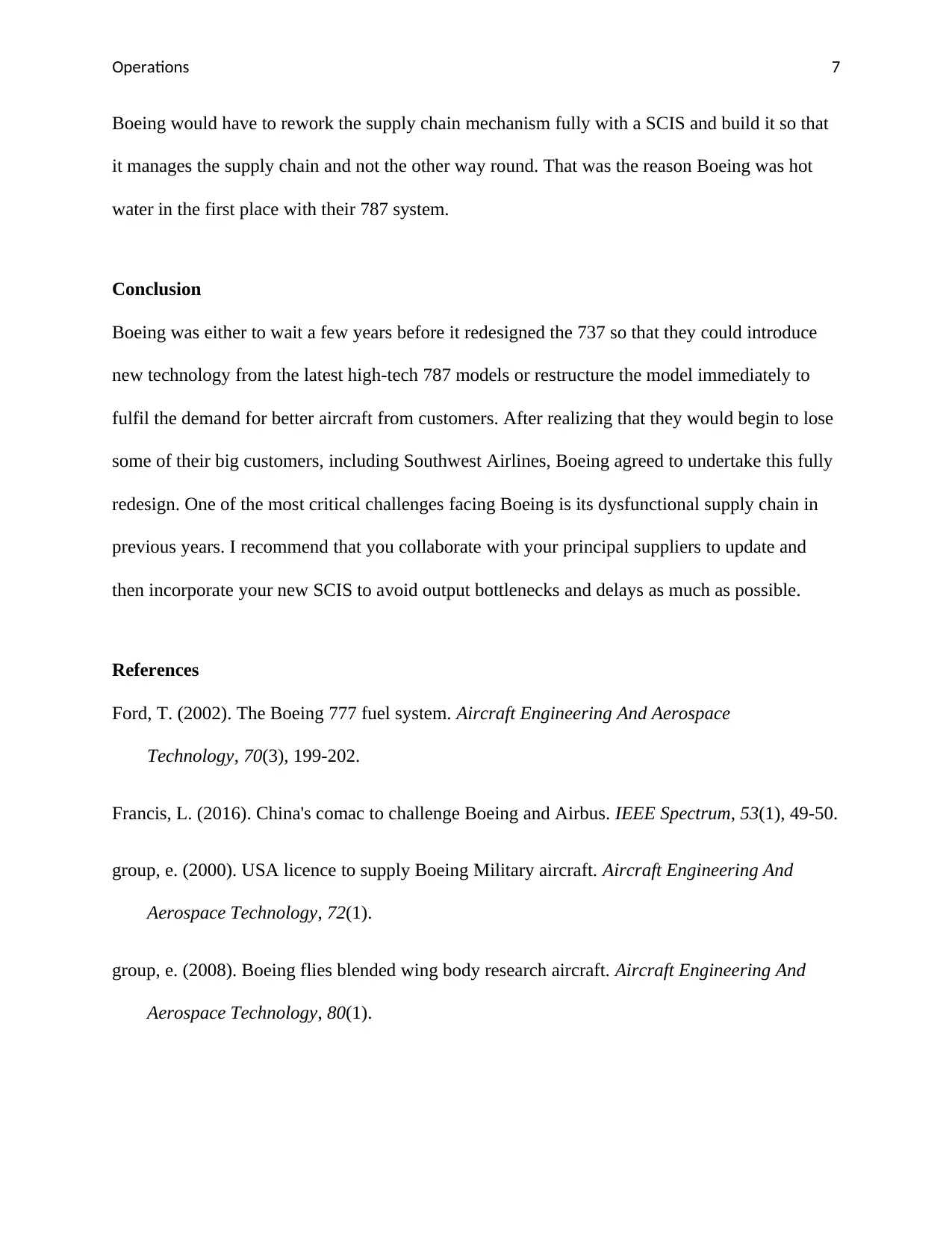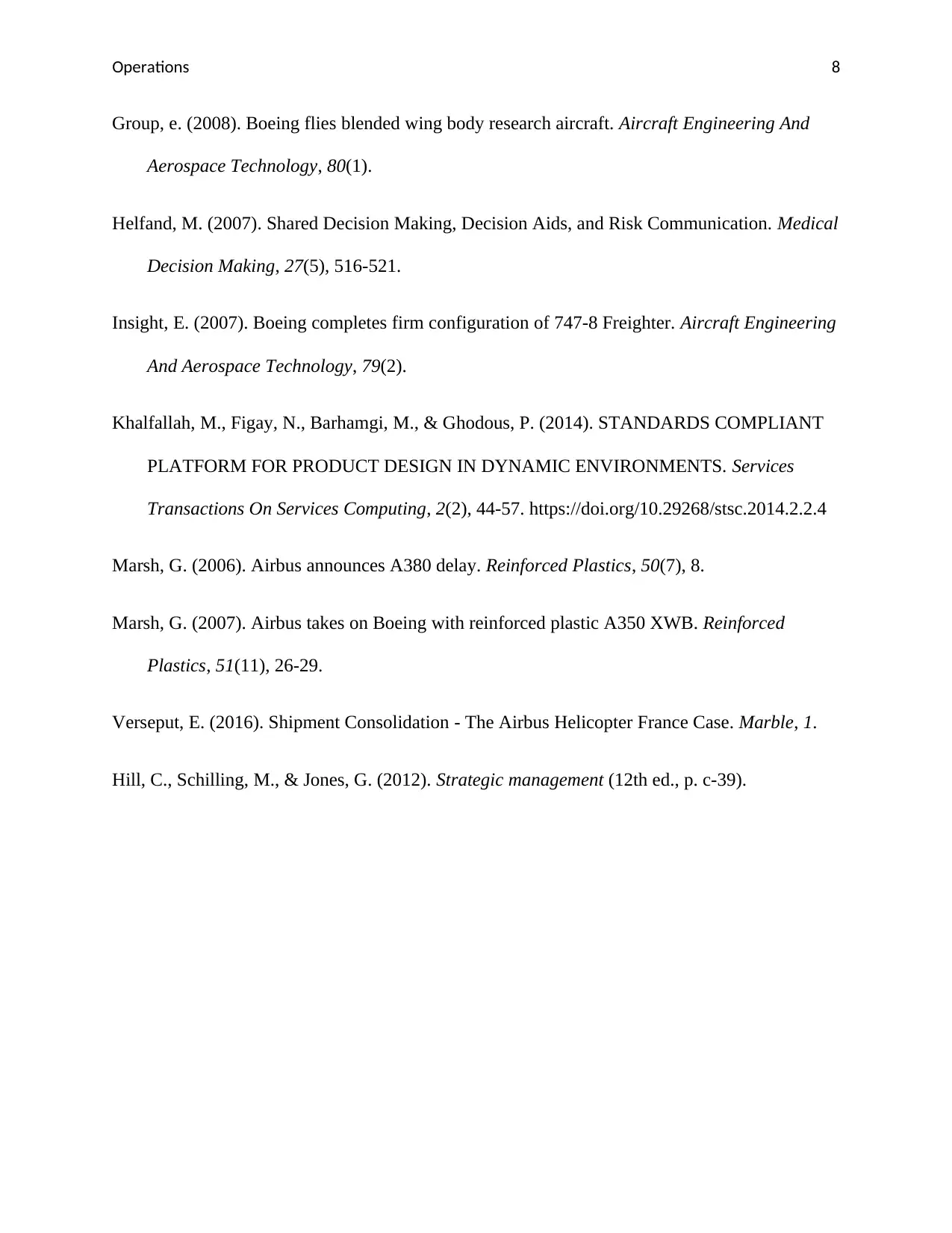Boeing 737MAX Redesign: Decision Making, Stakeholders, and Risks
VerifiedAdded on 2022/07/28
|9
|2218
|27
Report
AI Summary
This report provides a comprehensive analysis of Boeing's strategic decision to redesign the 737MAX aircraft. It examines the context of the competitive landscape, specifically the rivalry with Airbus, and the pressures from airlines for more fuel-efficient aircraft. The report explores Boeing's decision-making process, including the initial consideration to delay the redesign versus the eventual commitment to the 737MAX. It analyzes the concerns of shareholders and stakeholders regarding the supply chain and outsourcing of critical components. Furthermore, the report identifies and assesses the risks associated with the redesign, including supply chain vulnerabilities and the impact of global events. The discussion section considers the global implications of the decision and Boeing's future success, emphasizing the importance of supply chain reliability. The report concludes with recommendations for Boeing to improve its supply chain management. The report utilizes various sources to support its arguments and analysis.

Operations 0
Title:
Assignment Name:
Student Name:
Course Name and Number:
Professor:
Date:
Title:
Assignment Name:
Student Name:
Course Name and Number:
Professor:
Date:
Paraphrase This Document
Need a fresh take? Get an instant paraphrase of this document with our AI Paraphraser

Operations 1
Contents
Abstract............................................................................................................................................2
Introduction......................................................................................................................................3
1. Decision Making..........................................................................................................................4
2. Shareholders/Stakeholders Concerns...........................................................................................4
3. Risks for Boeing..........................................................................................................................5
Discussion........................................................................................................................................6
Conclusion.......................................................................................................................................7
References........................................................................................................................................7
Contents
Abstract............................................................................................................................................2
Introduction......................................................................................................................................3
1. Decision Making..........................................................................................................................4
2. Shareholders/Stakeholders Concerns...........................................................................................4
3. Risks for Boeing..........................................................................................................................5
Discussion........................................................................................................................................6
Conclusion.......................................................................................................................................7
References........................................................................................................................................7

Operations 2
Abstract
2006 looked like Boeing's three decades of global battle with Airbus would be the year in which
they would break out of this. Boeing has always lost its market share in Airbus since the mid
1990ies, even as the dominant player in the commercial aerospace industry. In 1999, Boeing was
the first in its history to receive significantly more orders for new commercial jet aircraft than
Boeing had from its long-standing competitor, Airbus. Airbus made this happen frequently
between 2001 and 2005 to make it harder for Boeing (Hill et al., 2012). By 2006, though, the tide
appeared to change to Boeing. The super-efficient 787, the tested and well known 737 and 777
aircraft, the main cause of the Boeings success at that time, were a significant increase in sales
for the new jet. In early 2006, Boeing obtained 487 orders for commercial aircraft, with only 117
being its main rival. After decades of battle with Airbus, and their difficulties after
manufacturing and moral controversies, it appeared that Boeing was now moving ahead. In
development issues, Airbus was mired and at that time significantly reversed them(Group, 2008).
Their production orders had to be reduced from 420 to 84, which they could only produce half by
2010. With its new large-scale 787 Boeing subsequently faced some production problems itself.
Boeing has contracted suppliers with a record number of jobs. At the time it was considered to be
a risky step, primarily because of the number of new technologies in the 787. Many vendors had
trouble complying with Boeing qualitative criteria, supplying subnormal parts to be reworked or
refurbished. Boeing launched a newly redesigned 747-8 model that saw lower sales figures than
average. Boeing and Airbus faced one of the biggest challenges in terms of their 737 and A320
staff fleets, which accounted for around 70 per cent and/or airline capacities(group, 2000). A
modern, more powerful engines had been built by Pratt & Whitney, which all industries were
trying to reduce operating costs by between 15%-20% because of the rising fuel costs at the time.
Abstract
2006 looked like Boeing's three decades of global battle with Airbus would be the year in which
they would break out of this. Boeing has always lost its market share in Airbus since the mid
1990ies, even as the dominant player in the commercial aerospace industry. In 1999, Boeing was
the first in its history to receive significantly more orders for new commercial jet aircraft than
Boeing had from its long-standing competitor, Airbus. Airbus made this happen frequently
between 2001 and 2005 to make it harder for Boeing (Hill et al., 2012). By 2006, though, the tide
appeared to change to Boeing. The super-efficient 787, the tested and well known 737 and 777
aircraft, the main cause of the Boeings success at that time, were a significant increase in sales
for the new jet. In early 2006, Boeing obtained 487 orders for commercial aircraft, with only 117
being its main rival. After decades of battle with Airbus, and their difficulties after
manufacturing and moral controversies, it appeared that Boeing was now moving ahead. In
development issues, Airbus was mired and at that time significantly reversed them(Group, 2008).
Their production orders had to be reduced from 420 to 84, which they could only produce half by
2010. With its new large-scale 787 Boeing subsequently faced some production problems itself.
Boeing has contracted suppliers with a record number of jobs. At the time it was considered to be
a risky step, primarily because of the number of new technologies in the 787. Many vendors had
trouble complying with Boeing qualitative criteria, supplying subnormal parts to be reworked or
refurbished. Boeing launched a newly redesigned 747-8 model that saw lower sales figures than
average. Boeing and Airbus faced one of the biggest challenges in terms of their 737 and A320
staff fleets, which accounted for around 70 per cent and/or airline capacities(group, 2000). A
modern, more powerful engines had been built by Pratt & Whitney, which all industries were
trying to reduce operating costs by between 15%-20% because of the rising fuel costs at the time.
⊘ This is a preview!⊘
Do you want full access?
Subscribe today to unlock all pages.

Trusted by 1+ million students worldwide

Operations 3
Boeing was faced with a major strategic problem with these innovations. Will you have to decide
what to do with the 737 and maybe wait a few years to make the big overhaul investment? This
will allow them to design a high-tech 737 replacement integrating many of the 787 technologies.
Otherwise, they will quickly leap into the fray and sell a redesigned 737 variant that could use
new engine technology(group, 2008).
Introduction
Within a highly competitive climate, Boeing and Airbus work together (Khalfallah et al., 2014).
We are the only two major business aircraft producers. Generally, their clients are the airlines,
government and big corporations. It is one of the leading innovators in the development of new
advanced commercial aircraft and technologies, that Boeing is in direct competition with
Airbus(Marsh, 2006). For instance, Boeing had to shift to a lean production process, not a mass
production that had been produced by Boeing managers during their visit to the Toyota facility in
Japan(Verseput, 2016). The latest procedure saved Boeing millions of dollars in fixed costs and
operating expenses. The original issue for Boeing is that it will or should not proceed with its
737MAX plan or wait a few years to invest more heavily in its full refurbishment(Insight, 2007).
If Boeing had been able to wait a few years, the 737 system could have been completely
refurbished to incorporate much of the high technology from the 787 programmes(Helfand,
2007). However, when they threatened to turn on Airbus and their A320neo instead of sticking
on the Boeing 737, Southwest Airlines forced their hand in the decision. The firms plan to take
care of Pratt & Whitney's higher-efficiency commercial aircraft engines(Ford, 2002).
Boeing was faced with a major strategic problem with these innovations. Will you have to decide
what to do with the 737 and maybe wait a few years to make the big overhaul investment? This
will allow them to design a high-tech 737 replacement integrating many of the 787 technologies.
Otherwise, they will quickly leap into the fray and sell a redesigned 737 variant that could use
new engine technology(group, 2008).
Introduction
Within a highly competitive climate, Boeing and Airbus work together (Khalfallah et al., 2014).
We are the only two major business aircraft producers. Generally, their clients are the airlines,
government and big corporations. It is one of the leading innovators in the development of new
advanced commercial aircraft and technologies, that Boeing is in direct competition with
Airbus(Marsh, 2006). For instance, Boeing had to shift to a lean production process, not a mass
production that had been produced by Boeing managers during their visit to the Toyota facility in
Japan(Verseput, 2016). The latest procedure saved Boeing millions of dollars in fixed costs and
operating expenses. The original issue for Boeing is that it will or should not proceed with its
737MAX plan or wait a few years to invest more heavily in its full refurbishment(Insight, 2007).
If Boeing had been able to wait a few years, the 737 system could have been completely
refurbished to incorporate much of the high technology from the 787 programmes(Helfand,
2007). However, when they threatened to turn on Airbus and their A320neo instead of sticking
on the Boeing 737, Southwest Airlines forced their hand in the decision. The firms plan to take
care of Pratt & Whitney's higher-efficiency commercial aircraft engines(Ford, 2002).
Paraphrase This Document
Need a fresh take? Get an instant paraphrase of this document with our AI Paraphraser

Operations 4
1. Argument 1- Decision Making
"Connect, defend, discover and empower the world through aerospace innovation" is Boeing's
core mission. Boeing is central to innovation in its sector, focused on providing outstanding
value to consumers, staff, shareholders, communities and partners. Boeing's fundamental aim is
to increase the efficiency, quality and profitability of each product/service where customer
loyalty and profitability are calculated in terms of performance and quality. to achieve the
relevant strategic goals and also to discuss the company's mission and vision.
Boeing has set a common set of targets, covering sustainable growth, highly qualified and
empowered employees, professional and committed management, technical excellence, financial
strength, and future credibility.
Boeing eventually agreed to embark out the full overhaul of the 737 system and turn it into
Southwest Airlines' 737MAX system to retain its role as a valued customer. Originally Boeing
decided to postpone the redesign a couple of years because they had more money from their 787
programmes. Originally Boeing decided to postpone the redesign a couple of years because they
had more money from their 787 programmes. Nevertheless, they faced some dilemmas when
Pratt & Whitney came up with a commercial aeroplane engine which was more fuel-efficient
than all airlines.
Many airlines started placing pressure on Boeing and Airbus for newly designed aircraft
integrating these engines, for good reason. Such engines would reduce the airlines' variable fuel
costs, thus rising their profit margins and also reducing their break-even points.
2. argument 2- Shareholders/Stakeholders Concerns
Boeing shareholders/stakeholders were aware of their reservations about the decision to
immediately push out the complete overhaul because the supply chain processes were not yet
1. Argument 1- Decision Making
"Connect, defend, discover and empower the world through aerospace innovation" is Boeing's
core mission. Boeing is central to innovation in its sector, focused on providing outstanding
value to consumers, staff, shareholders, communities and partners. Boeing's fundamental aim is
to increase the efficiency, quality and profitability of each product/service where customer
loyalty and profitability are calculated in terms of performance and quality. to achieve the
relevant strategic goals and also to discuss the company's mission and vision.
Boeing has set a common set of targets, covering sustainable growth, highly qualified and
empowered employees, professional and committed management, technical excellence, financial
strength, and future credibility.
Boeing eventually agreed to embark out the full overhaul of the 737 system and turn it into
Southwest Airlines' 737MAX system to retain its role as a valued customer. Originally Boeing
decided to postpone the redesign a couple of years because they had more money from their 787
programmes. Originally Boeing decided to postpone the redesign a couple of years because they
had more money from their 787 programmes. Nevertheless, they faced some dilemmas when
Pratt & Whitney came up with a commercial aeroplane engine which was more fuel-efficient
than all airlines.
Many airlines started placing pressure on Boeing and Airbus for newly designed aircraft
integrating these engines, for good reason. Such engines would reduce the airlines' variable fuel
costs, thus rising their profit margins and also reducing their break-even points.
2. argument 2- Shareholders/Stakeholders Concerns
Boeing shareholders/stakeholders were aware of their reservations about the decision to
immediately push out the complete overhaul because the supply chain processes were not yet

Operations 5
completely resolved. In many of the key parts in their commercial aircraft production, Boeing
had relied heavily on external suppliers. The three main supply companies are based in Japan
along with the fire, which can hinder the supply chain's output, with frequent earthquakes and
violent storms. Since they were not able to manage their supply chain properly, Boeing had
previously been faced with issues in the manufacturing process and others would say that they
were irresponsible. Unless Boeing had planned to overhaul its 737 system then the kinks in its
supply chain processes would have been better ironed. Shareholders were understandably upset
about Boeing's decision in the past to outsource the production of much of their aircraft's vital
components. To fix these problems in part, Boeing has acquired a Tier 1 supplier called Vought
Aircraft Industries to improve leverage overproduction and supply chain procedures. to resolve
these concerns partly and correct their previous mistakes. Thankfully they agreed to reinvent and
to bring the redesign forward for Boeing.
3. Argument 3- Risks for Boeing
In the first place, the advantages of redesign overwhelmed the risks in general. Boeing would
greatly benefit from new orders for its cutting-edge planes, which would save airline variable
fuel costs. Composites from the design of 787 have not only lowered weight but also made it
possible to pressurize the cab of their new aircraft at a higher pressure because the level of
humidity had to be not as low as with aluminium bodies. The airlines were also saving money for
preventive and corrective maintenance. The more fuel-efficient engines used to upgrade the
airlines have saved money on varying fuel prices(Francis, 2016).
One significant risk for Boeing was to re-define their supply chain by exceeding the capacity of
suppliers to manufacture and deliver the required parts on time by new aircraft orders. Western
Pacific natural disasters are very frequent, and Boeing's production ability had been hampered
completely resolved. In many of the key parts in their commercial aircraft production, Boeing
had relied heavily on external suppliers. The three main supply companies are based in Japan
along with the fire, which can hinder the supply chain's output, with frequent earthquakes and
violent storms. Since they were not able to manage their supply chain properly, Boeing had
previously been faced with issues in the manufacturing process and others would say that they
were irresponsible. Unless Boeing had planned to overhaul its 737 system then the kinks in its
supply chain processes would have been better ironed. Shareholders were understandably upset
about Boeing's decision in the past to outsource the production of much of their aircraft's vital
components. To fix these problems in part, Boeing has acquired a Tier 1 supplier called Vought
Aircraft Industries to improve leverage overproduction and supply chain procedures. to resolve
these concerns partly and correct their previous mistakes. Thankfully they agreed to reinvent and
to bring the redesign forward for Boeing.
3. Argument 3- Risks for Boeing
In the first place, the advantages of redesign overwhelmed the risks in general. Boeing would
greatly benefit from new orders for its cutting-edge planes, which would save airline variable
fuel costs. Composites from the design of 787 have not only lowered weight but also made it
possible to pressurize the cab of their new aircraft at a higher pressure because the level of
humidity had to be not as low as with aluminium bodies. The airlines were also saving money for
preventive and corrective maintenance. The more fuel-efficient engines used to upgrade the
airlines have saved money on varying fuel prices(Francis, 2016).
One significant risk for Boeing was to re-define their supply chain by exceeding the capacity of
suppliers to manufacture and deliver the required parts on time by new aircraft orders. Western
Pacific natural disasters are very frequent, and Boeing's production ability had been hampered
⊘ This is a preview!⊘
Do you want full access?
Subscribe today to unlock all pages.

Trusted by 1+ million students worldwide

Operations 6
before. Both these threats, however, are now being managed by Boeing. You should know that
their decision to outsource so much of their aircraft development and design was a major
mistake. To order to maintain tighter control of the production and supply chains, they are
seeking to solve this issue by buying other suppliers.
Discussion
The problem with the whole strategy could be the global decision impact and Boeing’s Future
Success. Customers in some 150 countries and staff and activities in more than 65 countries are
part of the worldwide effects of Boeing. It has worldwide manufacturing, business and
infrastructure alliances and contracts with more than 20,000 individual companies and partners.
Boying is the largest export company in the United States, with over 70 per cent of Boeing's
operations outside the USA. Due to its lightweight composite construction,
+fuel-efficient engines and superior consumer usability, the decision to upgrade their 737MAX
would attract new sales worldwide. Boeing will put new foreign aircraft orders ahead of Airbus
with the surge in demand across its worldwide market. Boeing has taken the latest technologies
to market with the redesign decision, which would enable Airbus and other commercial aircraft
manufacturers to innovate new and exciting forms of lighting, fuel efficiency, comfort and eco-
friendly aircraft(Marsh, 2007).
The potential success of Boeing relies on a variety of important problems. One question must,
therefore, be dealt with before the other; reliability of the supply chain. In addition to Vought's
acquisition, Boeing made it a priority to better communicate with its suppliers through the
transfer of its engineers and technical personnel to on-site vendors to fix any design issues.
before. Both these threats, however, are now being managed by Boeing. You should know that
their decision to outsource so much of their aircraft development and design was a major
mistake. To order to maintain tighter control of the production and supply chains, they are
seeking to solve this issue by buying other suppliers.
Discussion
The problem with the whole strategy could be the global decision impact and Boeing’s Future
Success. Customers in some 150 countries and staff and activities in more than 65 countries are
part of the worldwide effects of Boeing. It has worldwide manufacturing, business and
infrastructure alliances and contracts with more than 20,000 individual companies and partners.
Boying is the largest export company in the United States, with over 70 per cent of Boeing's
operations outside the USA. Due to its lightweight composite construction,
+fuel-efficient engines and superior consumer usability, the decision to upgrade their 737MAX
would attract new sales worldwide. Boeing will put new foreign aircraft orders ahead of Airbus
with the surge in demand across its worldwide market. Boeing has taken the latest technologies
to market with the redesign decision, which would enable Airbus and other commercial aircraft
manufacturers to innovate new and exciting forms of lighting, fuel efficiency, comfort and eco-
friendly aircraft(Marsh, 2007).
The potential success of Boeing relies on a variety of important problems. One question must,
therefore, be dealt with before the other; reliability of the supply chain. In addition to Vought's
acquisition, Boeing made it a priority to better communicate with its suppliers through the
transfer of its engineers and technical personnel to on-site vendors to fix any design issues.
Paraphrase This Document
Need a fresh take? Get an instant paraphrase of this document with our AI Paraphraser

Operations 7
Boeing would have to rework the supply chain mechanism fully with a SCIS and build it so that
it manages the supply chain and not the other way round. That was the reason Boeing was hot
water in the first place with their 787 system.
Conclusion
Boeing was either to wait a few years before it redesigned the 737 so that they could introduce
new technology from the latest high-tech 787 models or restructure the model immediately to
fulfil the demand for better aircraft from customers. After realizing that they would begin to lose
some of their big customers, including Southwest Airlines, Boeing agreed to undertake this fully
redesign. One of the most critical challenges facing Boeing is its dysfunctional supply chain in
previous years. I recommend that you collaborate with your principal suppliers to update and
then incorporate your new SCIS to avoid output bottlenecks and delays as much as possible.
References
Ford, T. (2002). The Boeing 777 fuel system. Aircraft Engineering And Aerospace
Technology, 70(3), 199-202.
Francis, L. (2016). China's comac to challenge Boeing and Airbus. IEEE Spectrum, 53(1), 49-50.
group, e. (2000). USA licence to supply Boeing Military aircraft. Aircraft Engineering And
Aerospace Technology, 72(1).
group, e. (2008). Boeing flies blended wing body research aircraft. Aircraft Engineering And
Aerospace Technology, 80(1).
Boeing would have to rework the supply chain mechanism fully with a SCIS and build it so that
it manages the supply chain and not the other way round. That was the reason Boeing was hot
water in the first place with their 787 system.
Conclusion
Boeing was either to wait a few years before it redesigned the 737 so that they could introduce
new technology from the latest high-tech 787 models or restructure the model immediately to
fulfil the demand for better aircraft from customers. After realizing that they would begin to lose
some of their big customers, including Southwest Airlines, Boeing agreed to undertake this fully
redesign. One of the most critical challenges facing Boeing is its dysfunctional supply chain in
previous years. I recommend that you collaborate with your principal suppliers to update and
then incorporate your new SCIS to avoid output bottlenecks and delays as much as possible.
References
Ford, T. (2002). The Boeing 777 fuel system. Aircraft Engineering And Aerospace
Technology, 70(3), 199-202.
Francis, L. (2016). China's comac to challenge Boeing and Airbus. IEEE Spectrum, 53(1), 49-50.
group, e. (2000). USA licence to supply Boeing Military aircraft. Aircraft Engineering And
Aerospace Technology, 72(1).
group, e. (2008). Boeing flies blended wing body research aircraft. Aircraft Engineering And
Aerospace Technology, 80(1).

Operations 8
Group, e. (2008). Boeing flies blended wing body research aircraft. Aircraft Engineering And
Aerospace Technology, 80(1).
Helfand, M. (2007). Shared Decision Making, Decision Aids, and Risk Communication. Medical
Decision Making, 27(5), 516-521.
Insight, E. (2007). Boeing completes firm configuration of 747-8 Freighter. Aircraft Engineering
And Aerospace Technology, 79(2).
Khalfallah, M., Figay, N., Barhamgi, M., & Ghodous, P. (2014). STANDARDS COMPLIANT
PLATFORM FOR PRODUCT DESIGN IN DYNAMIC ENVIRONMENTS. Services
Transactions On Services Computing, 2(2), 44-57. https://doi.org/10.29268/stsc.2014.2.2.4
Marsh, G. (2006). Airbus announces A380 delay. Reinforced Plastics, 50(7), 8.
Marsh, G. (2007). Airbus takes on Boeing with reinforced plastic A350 XWB. Reinforced
Plastics, 51(11), 26-29.
Verseput, E. (2016). Shipment Consolidation - The Airbus Helicopter France Case. Marble, 1.
Hill, C., Schilling, M., & Jones, G. (2012). Strategic management (12th ed., p. c-39).
Group, e. (2008). Boeing flies blended wing body research aircraft. Aircraft Engineering And
Aerospace Technology, 80(1).
Helfand, M. (2007). Shared Decision Making, Decision Aids, and Risk Communication. Medical
Decision Making, 27(5), 516-521.
Insight, E. (2007). Boeing completes firm configuration of 747-8 Freighter. Aircraft Engineering
And Aerospace Technology, 79(2).
Khalfallah, M., Figay, N., Barhamgi, M., & Ghodous, P. (2014). STANDARDS COMPLIANT
PLATFORM FOR PRODUCT DESIGN IN DYNAMIC ENVIRONMENTS. Services
Transactions On Services Computing, 2(2), 44-57. https://doi.org/10.29268/stsc.2014.2.2.4
Marsh, G. (2006). Airbus announces A380 delay. Reinforced Plastics, 50(7), 8.
Marsh, G. (2007). Airbus takes on Boeing with reinforced plastic A350 XWB. Reinforced
Plastics, 51(11), 26-29.
Verseput, E. (2016). Shipment Consolidation - The Airbus Helicopter France Case. Marble, 1.
Hill, C., Schilling, M., & Jones, G. (2012). Strategic management (12th ed., p. c-39).
⊘ This is a preview!⊘
Do you want full access?
Subscribe today to unlock all pages.

Trusted by 1+ million students worldwide
1 out of 9
Related Documents
Your All-in-One AI-Powered Toolkit for Academic Success.
+13062052269
info@desklib.com
Available 24*7 on WhatsApp / Email
![[object Object]](/_next/static/media/star-bottom.7253800d.svg)
Unlock your academic potential
Copyright © 2020–2025 A2Z Services. All Rights Reserved. Developed and managed by ZUCOL.


